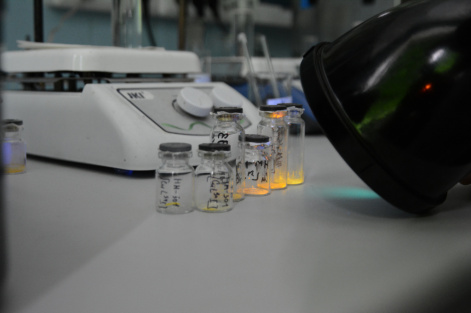A new type of bioluminescent aptasensor has been obtained
24 December 2020 г.

Aptamers are short fragments of nucleic acids that, due to their spatial structure, specifically bind to a specific target molecule. They have particular advantages: in vitro preparation, relatively simple, reproducible and economical chemical synthesis, long shelf life, and many chemical modification options. These molecules are currently a promising alternative to monoclonal antibodies for analytical and therapeutic applications.
The nature of aptamers allows scientists to create a variety of molecular structures based on them. The ability of these molecules to change their spatial structure after binding to a target opens up wide possibilities for creating biosensors. “These compounds provide a measurable, visual signal. In our case, the aptamer is used as a specific molecule, while as a signal molecule, use is made of enzymes whose products are either colored or glowing, ” says one of the authors of the study, chief researcher at the Institute of Biophysics of SB RAS, Doctor of Biological Sciences, Lyudmila Frank. As building blocks, aptamers are well compatible, so they can be combined like a Lego constructor to obtain complex multifunctional molecules, whose properties can be adjusted, depending on the research task.
“This is a new development. Our colleagues from the Institute of Biophysics in Krasnoyarsk are studying the properties of luminous bioluminescent proteins in order to create on their basis a variety of analytical systems with high sensitivity and specificity. In turn, our laboratory of RNA chemistry conducts systematic work on the creation of new aptamers, study of their properties and application possibilities. In the course of joint research, the idea arose to make bioluminescent biosensors, where aptamers would be recognizing elements, and the luminous protein obelin would be a signal molecule. Nobody has used such a combination of approaches before us, ” says Maria Vorobyova, a senior researcher at the RNA Chemistry Laboratory of the ICBFM SB RAS.
To date, aptamers have been described which can bind small fluorescent molecules and enhance their luminescence. For example, they are successfully used for RNA imaging. “In the course of our joint work, we have created a novel modified RNA aptamer for obelin and hemoglobin as a target and proposed a strategy for its integration into a bi-modular structure-switching construct. The problem is to correctly bind two aptamers, selected for different targets, so that they retain their functions, and the reporter module could bind to our protein only in the presence of the target, ” says Lyudmila Frank.
Having conducted a model bioluminescence analysis on microplates, the scientists found that such aptamer constructs bind their targets in a strictly sequential manner. In this case, the bioluminescent signal from obelin was observed only in the presence of hemoglobin, and the signal increased with the concentration of the protein.
“It is known that when a reporter is attached to a biospecific molecule by chemical synthesis, that is, through the formation of covalent bonds, its activity is partially, and sometimes significantly, lost. This leads to a decrease in the sensitivity of the analysis. We have shown that the resulting bi-modular aptamer is able to non-covalently bind to desired targets. The important thing here is that such an attachment does not spoil the molecule - the reporter fully retains its activity, ” says Lyudmila Frank.
The development proposed by the researchers can be applied to identify other targets. To do this, it is necessary to obtain a sensor module of the aptamer for another required target, and then dock it with a ready-made universal reporter module which recognizes a signaling molecule - a bioluminescent protein.
Source: Science in Siberia
Photo: Anastasia Fedotova
Share:
